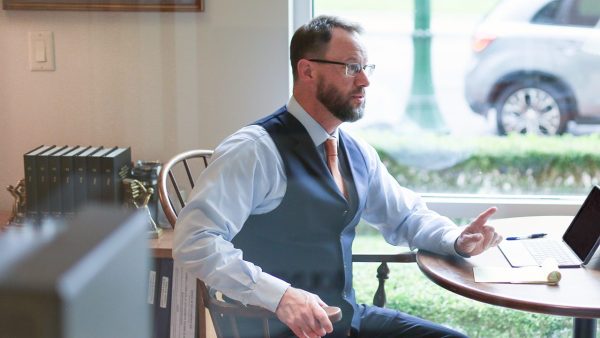Get our email updates
Stay up-to-date on the companies, people and issues that impact businesses in Syracuse, Central New York and beyond.
What's New
Upcoming Events
CNYBJ Job Board

Herkimer College launches associate degree program in AI – business
HERKIMER, N.Y. — Herkimer County Community College on Thursday said it’s launching an associate degree program in artificial intelligence (AI) – business. It’s designed to

Park Strategies, one of New York’s premier consulting and government-relations firms, announced that Central New York native Matt Geitner has joined the team as a

Doreen Borders, a 30-year veteran of the banking industry, has joined Canandaigua National Bank as a business banker officer in the Syracuse market. Borders brings

SUNY Broome graduates second class of future lineworkers
DICKINSON, N.Y. — The second group participating in SUNY Broome’s lineworker-training program has graduated. The school hosted a graduation ceremony on Oct. 20 in the Decker Health Science Center. The latest class of lineworker students has 17 graduates, who began the program in April 2025 with no prior experience or training to learn foundational skills
Get Instant Access to This Article
Become a Central New York Business Journal subscriber and get immediate access to all of our subscriber-only content and much more.
- Critical Central New York business news and analysis updated daily.
- Immediate access to all subscriber-only content on our website.
- Get a year’s worth of the Print Edition of The Central New York Business Journal.
- Special Feature Publications such as the Book of Lists and Revitalize Greater Binghamton, Mohawk Valley, and Syracuse Magazines
Click here to purchase a paywall bypass link for this article.
DICKINSON, N.Y. — The second group participating in SUNY Broome’s lineworker-training program has graduated.
The school hosted a graduation ceremony on Oct. 20 in the Decker Health Science Center.
The latest class of lineworker students has 17 graduates, who began the program in April 2025 with no prior experience or training to learn foundational skills for this “in-demand and highly skilled field,” SUNY Broome said.
Over the past several months, the students have been involved in classroom and hands-on training, completed a paid internship, and obtained certifications.
Lineworkers install, maintain, and fix electrical power systems. The physically demanding work involves operating on power lines, poles, and transformers.
SUNY Broome recently hosted a job fair to connect students with industry employers, including NYSEG, National Cable Services, Cable Services Company, Upstate Utilities, Triple E Power & Light, and Ferguson Electric, the school noted.
SUNY Broome is seeking prospective students for the 2026 lineworker training program. Those interested can complete an interest form online (https://connect.sunybroome.edu/register/?id=8a20d394-d410-4431-bc82-d3899a3dde55).

Syracuse Hearing Solutions expands to larger facility in Camillus
CAMILLUS, N.Y. — Syracuse Hearing Solutions has moved to a new, larger, and more comprehensive office located at 307 Kasson Road in the town of Camillus. The new Camillus location offers expanded space, modern technology, and enhanced comfort for patients seeking hearing-related services, according to an Oct. 31 announcement from Syracuse Hearing Solutions. In addition
Get Instant Access to This Article
Become a Central New York Business Journal subscriber and get immediate access to all of our subscriber-only content and much more.
- Critical Central New York business news and analysis updated daily.
- Immediate access to all subscriber-only content on our website.
- Get a year’s worth of the Print Edition of The Central New York Business Journal.
- Special Feature Publications such as the Book of Lists and Revitalize Greater Binghamton, Mohawk Valley, and Syracuse Magazines
Click here to purchase a paywall bypass link for this article.
CAMILLUS, N.Y. — Syracuse Hearing Solutions has moved to a new, larger, and more comprehensive office located at 307 Kasson Road in the town of Camillus.
The new Camillus location offers expanded space, modern technology, and enhanced comfort for patients seeking hearing-related services, according to an Oct. 31 announcement from Syracuse Hearing Solutions. In addition to this new office, Syracuse Hearing Solutions also operates a Fayetteville–area facility at the Lyndon Office Park, at 7000 E. Genesee St. in the town of DeWitt.
Syracuse Hearing Solutions held a recent ribbon-cutting ceremony to celebrate the opening of the new Camillus office. Dr. Nicole Anzalone, business owner and lead audiologist, cut the ribbon, surrounded by her dedicated team.
“Helping people reconnect with the sounds of life is what drives our work every day,” Dr. Anzalone, said in the announcement. “This new facility allows us to serve our patients even better — with advanced hearing care, personalized treatment options, and a welcoming environment.”
Syracuse Hearing Solutions says it provides a full range of services, including diagnostic hearing tests or hearing evaluations, hearing aids and fittings, tinnitus therapy, and custom hearing-protection options.
Syracuse Hearing Solutions is the DBA name of Preferred Audiology Care, LLC, which was established in September 2009, according to its website.
The new 307 Kasson Road location of Syracuse Hearing Solutions is situated in a nearly 3,100-square-foot professional office building on an almost one-half-acre parcel, according to Onondaga County’s online property records. The property is owned by an entity called 307 Kasson Road, LLC, of Marcellus, which purchased it for $225,000 in April 2024.

Former ambulance squad captain in North Country accused of stealing more than $14K in pay
MORIAH, N.Y. — The former captain of the Town of Moriah Ambulance Squad, Michael Moran, was recently arrested for allegedly stealing more than $14,000 from the town. State Comptroller Thomas P. DiNapoli, Acting Essex County District Attorney Michael P. Langey, and New York State Police Superintendent Steven G. James announced the arrest on Sept. 19.
Get Instant Access to This Article
Become a Central New York Business Journal subscriber and get immediate access to all of our subscriber-only content and much more.
- Critical Central New York business news and analysis updated daily.
- Immediate access to all subscriber-only content on our website.
- Get a year’s worth of the Print Edition of The Central New York Business Journal.
- Special Feature Publications such as the Book of Lists and Revitalize Greater Binghamton, Mohawk Valley, and Syracuse Magazines
Click here to purchase a paywall bypass link for this article.
MORIAH, N.Y. — The former captain of the Town of Moriah Ambulance Squad, Michael Moran, was recently arrested for allegedly stealing more than $14,000 from the town.
State Comptroller Thomas P. DiNapoli, Acting Essex County District Attorney Michael P. Langey, and New York State Police Superintendent Steven G. James announced the arrest on Sept. 19.
Michael Moran, 57, served as captain of the Town of Moriah Ambulance Squad and also worked for Essex County as an emergency medical technician (EMT). As captain of the squad, Moran was in charge of processing time sheets for payroll, including his own, per the announcement.
After receiving allegations of potential fraud regarding Moran and the ambulance squad, the New York State Police contacted DiNapoli’s office and a joint investigation began. A forensic audit by the comptroller’s investigative team revealed that from December 2023 through March 2025, Moran allegedly inflated the hours he worked for the squad and also paid himself for nearly 150 hours at the squad when he had also claimed to be working for Essex County. Based upon Moran’s false submissions, the Town of Moriah overpaid Moran $14,230 for hours not actually worked, including $2,816 for overlapping time, the comptroller’s office stated.
Moran is no longer employed by the ambulance squad or Essex County Emergency Medical Services.
He was charged with grand larceny in the third degree and arraigned before the Honorable Richard Carpenter in the Town of Moriah Court. He was due back in court on Oct. 21. As of publication time, no information was available about developments at that court proceeding.
“Moran allegedly diverted resources meant to protect his community into his own pocket,” DiNapoli said in the September announcement. “My thanks to Acting District Attorney Langey and the State Police for their continued partnership in fighting corruption.”

ScriptStop Pharmacy formally opens in Whitesboro
WHITESBORO, N.Y. — ScriptStop Pharmacy recently cut the ribbon on its new store in Whitesboro. The new, independent pharmacy owned by Tom Giglio held a grand opening and ribbon-cutting ceremony with the Great Utica Chamber of Commerce on Sept. 15 at its location at 131 Oriskany Blvd. in Whitesboro. Giglio brings his experience from years
Get Instant Access to This Article
Become a Central New York Business Journal subscriber and get immediate access to all of our subscriber-only content and much more.
- Critical Central New York business news and analysis updated daily.
- Immediate access to all subscriber-only content on our website.
- Get a year’s worth of the Print Edition of The Central New York Business Journal.
- Special Feature Publications such as the Book of Lists and Revitalize Greater Binghamton, Mohawk Valley, and Syracuse Magazines
Click here to purchase a paywall bypass link for this article.
WHITESBORO, N.Y. — ScriptStop Pharmacy recently cut the ribbon on its new store in Whitesboro.
The new, independent pharmacy owned by Tom Giglio held a grand opening and ribbon-cutting ceremony with the Great Utica Chamber of Commerce on Sept. 15 at its location at 131 Oriskany Blvd. in Whitesboro.
Giglio brings his experience from years at Rite Aid along with familiar faces and members of the staff from the recently closed store to work at ScriptStop, according to a chamber announcement. That includes pharmacists John Castano and Amy Hughes, and many members of the technician team.
ScriptStop Pharmacy offers a comprehensive range of services including prescriptions and no-appointment-needed vaccines. Pharmacy hours are Monday to Friday from 8 a.m.-8 p.m., Saturday from 9 a.m.-5 p.m., and Sunday from 9 a.m.–3 p.m.

NYSERDA appoints Costello as COO
ALBANY, N.Y. — The New York State Energy Research and Development Authority (NYSERDA) on Oct. 29 announced that its board of directors has appointed Peter Costello as chief operating officer (COO). In this role, Costello, who has served as the authority’s general counsel since 2019 and secretary to the authority since 2020, will continue to
Get Instant Access to This Article
Become a Central New York Business Journal subscriber and get immediate access to all of our subscriber-only content and much more.
- Critical Central New York business news and analysis updated daily.
- Immediate access to all subscriber-only content on our website.
- Get a year’s worth of the Print Edition of The Central New York Business Journal.
- Special Feature Publications such as the Book of Lists and Revitalize Greater Binghamton, Mohawk Valley, and Syracuse Magazines
Click here to purchase a paywall bypass link for this article.
ALBANY, N.Y. — The New York State Energy Research and Development Authority (NYSERDA) on Oct. 29 announced that its board of directors has appointed Peter Costello as chief operating officer (COO).
In this role, Costello, who has served as the authority’s general counsel since 2019 and secretary to the authority since 2020, will continue to serve as part of NYSERDA’s executive leadership team, managing authority-wide operations and optimizing outcomes by promoting operational excellence, efficiency, and effectiveness, per the announcement.
As COO, Costello will oversee all authority-wide operational functions including human resources, contract management, facilities, and information-technology services. Under his leadership, the office of the COO will balance day-to-day operations alongside longer-term change initiatives at the authority, NYSERDA said.
Doreen M. Harris, president and CEO of NYSERDA said, regarding Costello’s appointment, “New York State is at a critical point as we plan for meeting future energy demands and challenges while prioritizing an energy system that is reliable, clean and affordable. We are thrilled to transition Peter’s undeniable skillset and experience into this new executive role. Peter will provide trusted direction and seasoned insight to help turn NYSERDA’s organizational strategy into day-to-day results, drive growth and stability and propel our mission forward while we accelerate our work across all sectors of the economy.”
Costello will remain the secretary to the authority until a new general counsel is appointed. NYSERDA’s senior deputy general counsel, Janice Dean, will serve as acting general counsel in the interim, the announcement stated.

Utica engineering firm is under new ownership
UTICA, N.Y. — Eisenbach & Ruhnke Engineering, P.C., an engineering firm based in Utica, is now under the ownership of Joseph C. Lu Engineering, PC, dba Lu Engineers, a Rochester–based engineering firm with offices in the Syracuse area and Binghamton. With Lu Engineers expanding its presence to Utica, the firm will “gain stronger access to
Get Instant Access to This Article
Become a Central New York Business Journal subscriber and get immediate access to all of our subscriber-only content and much more.
- Critical Central New York business news and analysis updated daily.
- Immediate access to all subscriber-only content on our website.
- Get a year’s worth of the Print Edition of The Central New York Business Journal.
- Special Feature Publications such as the Book of Lists and Revitalize Greater Binghamton, Mohawk Valley, and Syracuse Magazines
Click here to purchase a paywall bypass link for this article.
UTICA, N.Y. — Eisenbach & Ruhnke Engineering, P.C., an engineering firm based in Utica, is now under the ownership of Joseph C. Lu Engineering, PC, dba Lu Engineers, a Rochester–based engineering firm with offices in the Syracuse area and Binghamton.
With Lu Engineers expanding its presence to Utica, the firm will “gain stronger access to local and municipal markets and increase capacity to support projects throughout the Utica region,” per the Lu Engineers announcement.
The acquisition closed on Oct. 19, Lu Engineers tells CNYBJ in an email. The firm didn’t disclose any financial terms of the purchase.
Prior to the deal, Lu Engineers had 102 employees and is adding eight staff members from Eisenbach & Ruhnke Engineering.
Eisenbach & Ruhnke brings a team of engineers, scientists, specialists, energy managers and auditors who provide advanced energy and environmental engineering solutions in areas that complement Lu Engineers’ established strength in civil/site, transportation engineering and environmental consulting. The acquisition enables Lu Engineers to pursue “larger and more complex” projects throughout New York state and to diversify projects to include mechanical, electrical and plumbing (MEP) engineering services.
“We’re a small firm but a mighty firm that keeps growing every day. The acquisition is a strategic opportunity for us and impactful to our growth,” Cletus Ezenwa, president and CEO of Lu Engineers, contended in the announcement. “Lu Engineers has a great reputation for transportation and environmental projects, and expanding our capabilities to support mechanical, electrical and plumbing (MEP) services will enable us to serve on a broader scale and deliver even greater value to our clients.”
Lu Engineers is a veteran-owned, New York State-certified Disadvantaged and Minority-owned Business Enterprise. For more than 45 years, Lu has provided engineering, technical, and operational services to federal, state, and local governments, as well as private industries and developers.
“We are excited to become part of Lu Engineers; a firm committed to quality and serving its clients,” Jack Eisenbach, former CEO of Eisenbach & Ruhnke Engineering, P.C., said in the announcement. “Eisenbach & Ruhnke Engineering has been in existence for almost 40 years, and we have worked with many engineering firms. Our staff is committed to maintaining the quality of service for the clients of the combined firm.”
Eisenbach also tells CNYBJ that the transaction represents a succession plan after 39 years of owning the business, but he plans to continue working for two years part time as a senior associate.
Besides Rochester, DeWitt, and Utica, Lu Engineers also has offices in Buffalo and New York City.

Two Syracuse law firms to combine to become Costello Cooney Fearon & Fetter
SYRACUSE, N.Y. — The Syracuse law firms of Costello, Cooney & Fearon, PLLC and Scolaro Fetter Grizanti & McGough, P.C. are looking ahead to the new year when they will officially combine and become Costello Cooney Fearon & Fetter. “Costello Cooney Fearon & Fetter will build upon a combined 175 years of legal tradition in
Get Instant Access to This Article
Become a Central New York Business Journal subscriber and get immediate access to all of our subscriber-only content and much more.
- Critical Central New York business news and analysis updated daily.
- Immediate access to all subscriber-only content on our website.
- Get a year’s worth of the Print Edition of The Central New York Business Journal.
- Special Feature Publications such as the Book of Lists and Revitalize Greater Binghamton, Mohawk Valley, and Syracuse Magazines
Click here to purchase a paywall bypass link for this article.
SYRACUSE, N.Y. — The Syracuse law firms of Costello, Cooney & Fearon, PLLC and Scolaro Fetter Grizanti & McGough, P.C. are looking ahead to the new year when they will officially combine and become Costello Cooney Fearon & Fetter.
“Costello Cooney Fearon & Fetter will build upon a combined 175 years of legal tradition in Syracuse while establishing a stronger foundation to serve clients across the region and beyond,” the firms contended in their announcement.
Costello, Cooney & Fearon currently operates at 211 W. Jefferson St. in the Jefferson Clinton Commons building, located near the MOST. Scolaro Fetter Grizanti & McGough currently operates at 507 Plum St. in Syracuse’s Franklin Square area.
The Costello firm tells CNYBJ in an email that even though their names won’t be part of the combined firm’s name, attorneys Anthony Grizanti and Stewart McGough are remaining with the combined firm. The Costello firm also indicated the late Richard Scolaro died back in 2015.
As of Nov. 3, Costello, Cooney & Fearon has 37 attorneys and 37 staff members, while Scolaro Fetter Grizanti & McGough has eight lawyers, with an additional attorney joining the combined firm as of Jan. 5, 2026, along with 13 staff members, per the email response from the Costello firm.
From advising local businesses and municipalities to guiding families through generations of change, both “firms share a common history of helping the region grow and thrive,” they say.

“Bringing our firms together unites the collective strength of two highly successful practices with a shared vision for delivering the highest quality client service,” Jeffrey Fetter, CEO of Scolaro Fetter Grizanti & McGough, said in the announcement. “This combination will allow us to offer a broader range of legal services to meet the evolving needs of our present and future clients.”
The combined law firm will offer “expanded strength” in litigation, business and tax law, mergers and acquisitions, estate and trust planning and administration, municipal and education law, real estate, family law, health care, and agricultural law.
Initially, the combined law firm will operate from the 211 W. Jefferson St. location with a satellite office at 507 Plum St., but everyone will eventually be moving to the West Jefferson Street location, the Costello firm tells CNYBJ.
As of Nov. 3, Costello, Cooney & Fearon has offices in Syracuse, Cazenovia, and Albany, while Scolaro Fetter Grizanti & McGough has offices in Syracuse and in Stuart, Florida. The combined Costello Cooney Fearon & Fetter will operate offices in Syracuse, Albany, and Cazenovia, as well as Stuart, Florida.
“This is an important and exciting moment for both of our firms. Combining with Scolaro Fetter Grizanti & McGough strengthens the services we can provide to our clients and creates new opportunities for our attorneys and staff,” John Langey, CEO of Costello, Cooney & Fearon, said.
Get our email updates
Stay up-to-date on the companies, people and issues that impact businesses in Syracuse, Central New York and beyond.
